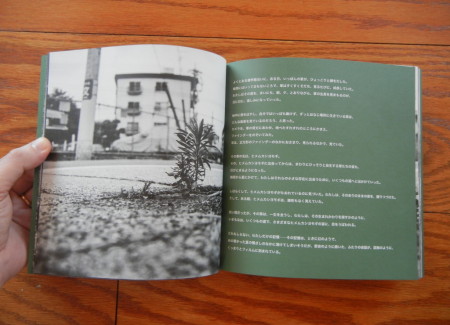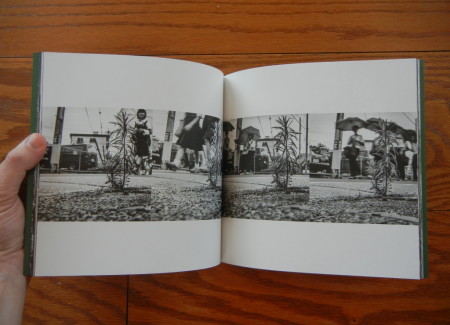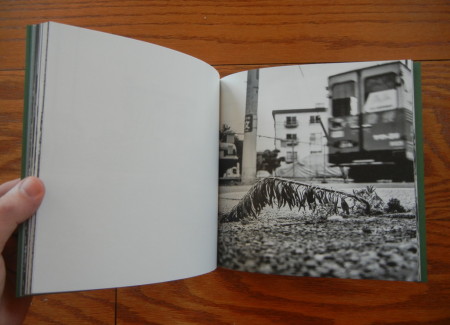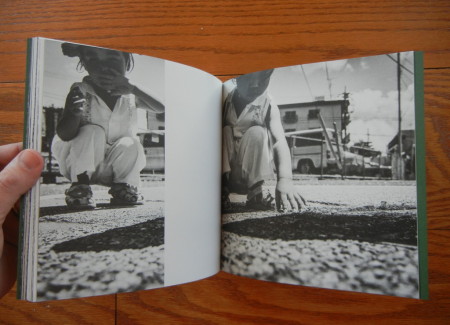JTF (just the facts): Published in 2014 by Mado-sha Publishing (here). Soft cover with clear PVC sleeve, 72 pages, with 58 black and white photographs. Includes a text by the artist in both English and Japanese. (Spread shots below.)
Comments/Context: One of the most obvious byproducts of spending a decent amount of time with a camera in your hands is that a distinct change starts to occur in your attention to the nuances and details in the world around you. It’s something about the action of consciously seeing, choosing, and framing that makes us much more acutely observant – we start to see with a kind of hypersensitivity to aspects of life we previously bypassed without so much as a fleeting thought, and that heightened sense of photographic awareness can transform our everyday experience into a series of small wonders.
The South Korean photographer Mi-Yeon’s newest photobook project feels like a purposefully intimate exercise in this kind of visual mindfulness. As she walked along the bustling sidewalks of Tokyo, she came upon a single optimistic weed struggling to make a life amid the urban concrete. Over a period of perhaps days or weeks, she captured its life and death story, getting down on the ground and making worm’s eye views (like Eggleston’s tricycle) of the weed and its immediate (and unforgiving) surroundings.
As the pages turn, we see the cropped feet of pedestrians pass by – school kids and workers in uniforms, people walking dogs, and clumps of umbrellas on grey days. The wheels of bicycles, cars, and trams blur by, their intense motion and power (like Lartigue’s distorted racecar) seeming to dwarf the plucky but insignificant plant. At night, the lonely weed stands amid the shadows and the streetlights, the movement of the day reduced to muted silence. As the days pass, we see the weed grow from an expectant seedling to a tall, proud tower, its leaves reaching out in search of moisture, almost challenging the apartment blocks in the background for visual dominance.
But the arc of this story includes both up and down, and so one sad day we discover the weed has toppled over. After a few hopeful days where recovery seems at least possible, the evitable begins, and in the final pages of the book, we watch as the weed slowly dies, shrinking and drying up, ultimately returning to a simple empty patch of dirt. While nearly all of the action passing by has been entirely indifferent to the plight of the weed, at the end, a cute young girl crouches down and touches the spot where the weed once stood, seeming to wonder where her friend had gone.
In the hands of a photographer less skillful than Mi-Yeon, this small project might easily have felt heavy handed and cloyingly sweet, like a children’s book story of the cycle of life. But her high contrast grainy pictures insert a mixed mood of uncertainty and beauty into this tiny narrative. Images of other isolated weeds have also been interspersed, many of which are more flattened and abstract, using the concrete environment of paving stones, painted parking lines, rocks, manhole covers, and sewer pipes as a visual contrast between the natural and the man made. When we return to our favorite weed, it feels both like one of a cadre of hard working strivers and simultaneously more strongly and boldly architectural. We notice its unique personality.
The subtle power of this work is that it reveals itself to be deeper and richer than it initially looks. Hang four of these pictures in a grid and you’ll get a tightly executed conceptual exercise in passing time. Focus on their tactile grittiness (and the life going on in the background) and you can see aesthetic connections to Moriyama; focus instead on the bright optimism and sensitive wonder of the series and you’ll find bridges to Kawauchi. Mi-Yeon has documented the endearing poetry of this small story and encouraged us to engage with its hidden elegance and universal struggle. Even the Who Might You Be? in the book’s title can be read in two ways – both as a tenderly addressed question to the fragile unknown plant, and using the life of the weed as a model, as a more pointed and ponderous one for the reader.
Collector’s POV: Mi-Yeon does not appear to have gallery representation at this time. As a result, interested collectors should likely follow up directly with the artist via her website (linked in the sidebar).



















If the protagonist of an Haruki Murakami novel.bought a camera these are the photographs I’d expect to result.